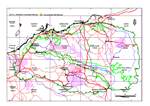Click on images
to enlarge



Photographer: B.R. Maslin

Photographer: B.R. Maslin

Photographer: B.R. Maslin
, AC Kalotas 1605, lab photo by Fiona McCallum ADJUSTED_sml.jpg)
Seed from one herbarium voucher. Scale in mm. Photographer: F. McCallum.
Botanical name
Acacia ligulata A. Cunn. ex Benth., London J. Bot. 1: 362 (1842)
Common name
Dune Wattle (preferred common name), Umbrella Wattle, Umbrella Bush, Small Cooba, Wirra, and more
Aboriginal name
Pakurta (Kariyarra)
Description
Glabrous, spreading, mid-dense shrubs 2-3 m tall and about the same across. Phyllodes narrowly oblong-elliptic or linear, 40-65 mm long, 3-9 mm wide, l:w = 5-21, normally sub-fleshy and smooth when fresh (normally finely wrinkled when dry), straight to shallowly incurved, rarely shallowly recurved or shallowly sigmoid , dull green; midrib obscure or obvious; lateral nerves superficially absent; apex eccentrically mucronulate, sometimes shallowly recurved to sub-uncinate. Glands 3 or 4 along upper margin of phyllode, the lowermost gland 4-13 mm above the pulvinus, the apical gland at base of or near the mucro. Inflorescences short racemes 1-15 mm long; peduncles 5-11mm long; heads globular, golden, sub- densely 24-26-flowered. Flowers 5-merous; calyx ±truncate; petals nerveless. Pods commonly straight-sided or slightly constricted between seeds, breaking readily into 1-seeded segments, 5-9 cm long, 5-9 mm wide, spreading to erect, thick, woody, yellow or light brown with often a paler median stripe. Seeds longitudinal, obloid-ellipsoid, normally 4-6 mm long, 3-4 mm wide, shiny, brown; aril yellow-orange or bright red.
Characteristic features
Glabrous shrubs. Phyllodes narrowly oblong-elliptic or linear, smooth and sub-fleshy when fresh, normally finely wrinkled when dry, dull green, 1-nerved, lateral nerves not evident. Glands 3 or 4 along upper margin of phyllode, the basal one 4-13 mm above the pulvinus, gland also at apex of phyllode at base of or near the excentric mucro. Inflorescences short racemes (1-15 mm long); heads golden. Pods thick and woody, readily breaking at constrictions between the seeds, 5-9 mm wide. Seed aril yellow-orange or bright red.
Distribution and ecology
Widespread in central and southern arid Australia, occurring in all mainland states. Acacia ligulata is rare in the Pilbara having been recorded from near Wickham and the Karratha back beach areas on the west coast, from Christie Crossing on the Oakover River and near the Gregory Range in the east of the region. Across its extensive range A. ligulata is commonly found on sandy soils.
Flowering and fruiting period
Flowers occur in July and August. Pods are unknown for Pilbara plants.
Variation
The specimen from near Gregory Range is atypical in that its dry phyllodes are smooth (not wrinkled), suggesting that unlike most specimens of A. ligulata they were not sub-fleshy when fresh.
Taxonomy
The taxonomic status of A. ligulata in the Pilbara is uncertain and requires further study. The above description is based on the three (flowering) Pilbara collection of this species, except for the pod and seed descriptions which were taken from literature.
Over its extensive geographic range A. ligulata is a variable species and the group in which it occurs is taxonomically very complex (see Chapman and Maslin 1992 for discussion).
Affinities
Acacia ligulata belongs to a group of related species called the A. bivenosa group (see Chapman and Maslin 1992 for discussion). There are four taxa referable to this group in the Pilbara, A. ampliceps, A. bivenosa, A. ligulata and A. sclerosperma subsp. sclerosperma. Acacia ligulata is most closely related to A. bivenosa which is distinguished by its normally wider, 2-nerved phyllodes with a lower l:w ratio, and by its often simple (not racemose) inflorescences with normally longer peduncles. Some specimens of A. ligulata may superficially resemble A. bivenosa x sclerosperma subsp. sclerosperma.
Notes
A fast growing, hardy species suited for low windbreaks and soil stabilisation in arid areas. It can spread by suckers and will re-shoot from a damaged crown.
The foliage is not highly palatable for stock in Western Australia and Northern Territory but in New South Wales it is sometimes eaten.
As discussed by Latz (1999) this species had many uses for the indigenous peoples of central Australian.
Conservation status
Not considered rare or endangered.
Origin of name
The botanical name is derived from the Latin ligula (a little tongue) and -atus (provided with), presumably in reference to the shape of the phyllodes.
References
Chapman, A.R. and Maslin, B.R. (1992). Acacia Miscellany 5. A review of the A. bivenosa group (Leguminosae: Mimosoideae: Section Phyllodineae). Nuytsia 8(2): 249-283.
Latz, P.K. (1999). Pocket Bushtucker: a field guide to the plants of Central Australia and their traditional uses. pp. 215. (IAD Press: Alice Springs.)
